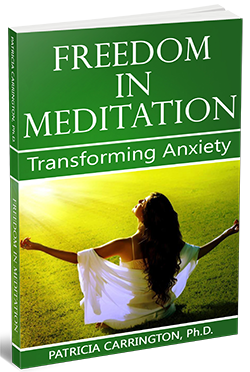Managing Tension-Release during Meditation
The list of tension-release side-effects compiled by teachers of autogenic training coincides remarkably with those we see in meditators.1 Although they are entirely normal occurrences, the person who experiences these effects can sometimes be upset by them, if not warned ahead of time, and may need advice on how to handle them.
The relaxing person may, for instance, feel unaccountably heavy in the relaxed state, as though ‘sinking down through the floor’, or may feel quite the opposite – weightless, as if ‘floating away’. Such sensations may affect the whole body, or only one specific part, such as arms, legs or head. After the relaxation session is over, there is usually no carry-over of these effects into daily life.
During deep relaxation, sensations of intense heat, icy cold, or a burning feeling sometimes occur. The deeply relaxing person may have a sudden itch that comes and goes. She may experience feelings of tingling or even a temporary numbness in some part of the body, or may feel pulsations coursing through the body or over the top of the head. Often these sensations are pleasant. Occasionally they are disturbing, as if an ‘electric current’ was running through the body, or as if there was ‘a steel band around the head’ or a sudden tightness in certain parts of the body. Relaxers sometimes even perspire profusely, shiver or find themselves trembling, or if tension release is particularly intense, their hearts may pound or they may breathe rapidly. These reactions seem ultimately to be useful in ‘unwinding,’ because the result of such a seemingly difficult session is often deep relaxation afterward.
A person in a state of deep relaxation sometimes has other experiences as well. He or she may have the impression of almost ‘smelling’ certain scents, as though ‘in a barn and there is hay which smells good’, or ‘on a beach feeling the wind and breathing in the strong salty smell of the sea’, or ‘in grandmother’s kitchen breathing the scent of freshly baked bread’. Smells – pleasant, unpleasant or neutral – can seem startlingly real at that time. In the same way, the relaxer may experience vivid sensations of taste, such as that of freshly ground pepper on the tongue, or of milk, or honey, or mustard, and the like.
The person’s concept of his or her own body may also change during deep relaxation: meditators’ hands may feel as though they were ‘as large as the room’ or the person’s head may feel ‘like a blown-up balloon’. The individual may even feel as though his or her legs, arms or head were separated from the body or that there is no body; or the individual may experience him or herself as incredibly ‘tiny’. Such sensations are often pleasant.
On the other hand, the relaxer sometimes has momentary discomforts such as pains that come and go, a headache, a stinging sensation in a toe or finger or elsewhere. His or her throat may suddenly feel sore and then clear up again within a matter of minutes. Saliva may be excessive causing continual swallowing, his or her mouth may dry up, the nose may run, or there may be sneezing or coughing. Some may sigh involuntarily or yawn repeatedly or make automatic sucking movements with their lips, or their stomach may growl unmercifully. In rare cases of extreme tension-release, individuals sometimes experience some nausea or have a strong urge to urinate.
The relaxing person may also notice small muscle twitches or jerks or involuntary movements, or ‘see’ all kinds of fascinating images – showers of sparks, spirals, whirls, geometric forms, textile-like patterns, vivid colors, bright lights.
The person may also ‘hear’ inner ‘sounds’ such as a humming in the head or a rushing, whirring, or ringing. Often these sounds are experienced as rare and beautiful as, ‘a thousand crickets chirping’ or ‘a tinkling chorus of tiny bells’. At other times it seems as though the body were tilted over at an extreme angle, falling over, or upside-down. Again, these experiences may be either pleasant or unpleasant according to whether or not the person is threatened by their unusual quality.
It is not exceptional for those in deep relaxation to experience intermittent waves of intense restlessness where they feel they ‘simply can’t stand it another second without getting up’, or they may have strong emotional reactions or burst into laughter or tears. They may also feel intense rage or have pleasurable sexual sensations or even experience orgasm.
These are just some of the forms that tension-release during deep relaxation can take. Very few of these side-effects are experienced by any one person, however, and they are usually most noticeable for about two weeks after commencing meditation, after which they fade rapidly. Some people, in fact, experience such mild forms of tension-release, even at first, that they never notice this process. Each person’s particular pattern of stress-release also varies. Some may experience certain specific side-effects over and over again in a number of meditations until these are eventually replaced by other characteristic effects (or none).
It should be emphasized that side-effects need not be present for a person to benefit from meditation, although they can be beneficial when they occur. A meditator should neither expect them nor be surprised if they do not appear. Usually they will take care of themselves. If not, then there are several effective ways to handle them, which are discussed in the related articles.
MEDITATION AUDIO
Problems Encountered with Meditation
Dr. Carrington discusses problems, such as tension release side-effects, frequently encountered by new meditators and offers advice regarding them.
Relation of Tension-Release to Life History
Not only does every meditator have a characteristic pattern of tension-release, but the particular pattern experienced may be meaningful in terms of the person’s unique life history. Autogenic training specialists have reported some striking parallels between patients’ past experiences and the tension-release patterns they characteristically report.
They found that particularly intense side-effects were most apt to occur in very anxious people who had at one time or another in their lives experienced severe accidents. Their pattern of tension release was related to the site of the injury and often involved the sensations that were originally associated with the accident.
A young man of twenty-four who had come for autogenic treatment because of anxiety reactions and some troubling depression is reported to have suddenly burst out laughing during his relaxation session. Later he told his therapist that he had been experiencing a feeling as though a stick were being pushed into his left upper abdomen just below the ribs and that his eyelids had been very tense, as though held together. At the same time he had had a feeling as though his heart was beating more strongly. Interestingly enough, this young man felt quite comfortable after the relaxation session was over, a response which is not unusual following intense tension-release. When he discussed these side-effects with his therapist, he then recalled three minor hockey accidents in which he had been involved between the ages of thirteen and eighteen. During one collision a hockey stick had been pushed into his upper abdomen and he had lost his breath and almost fainted.
This patient’s tension-release paralleled the feelings and experiences he had during his accidents. Not only did he repeatedly feel the stick pushed into his abdomen below his ribs during relaxation, but his eyelids had also been pressed together, possibly in response to the shock of the accident which was being ‘re-run’ during the relaxation session. This particular side-effect is reported to have recurred a number of times during this patient’s autogenic training sessions, as though a trauma had to work off its effect by being repeated.2
Other traumatic situations as well may be reflected in specific tension-release patterns. Women with a history of abortion carried out under particularly unfavorable circumstances, or who had had a traumatic delivery, showed disagreeable kinds of stress-release involving their abdominal region and their lower back when they relaxed in autogenic training.3 These side effects diminished and often ceased later on, again as though the physical traumas had been ‘worked out’ of their systems in the deep relaxation of the autogenic state.*
Another group, which showed tension-release patterns related to previous trauma, were schizophrenic patients who had received long series of electroshock treatments. These patients reported many more side-effects which involved a loss of balance (floating, sinking, etc.) when in autogenic relaxation than did schizophrenic patients who had never had shock treatments.4
Can Sexual Deprivation Contribute to Meditation Side-Effects?
Another area of trouble which may reflect itself in specific side-effects is sexual deprivation. In a study conducted by autogenic training researchers, sexually deprived people were compared with people who had fairly normal sex lives and ‘satisfying affectionate relationships with persons of the opposite sex’.5 The sexually deprived people showed a great many more side-effects of all kinds than did the non-deprived people.* They also had more sexually oriented visual experiences and thoughts. The sensations and movements during relaxation which happened to involve thighs, lower abdomen and genitals were almost six times as frequent in this deprivation group as in people who were not sexually deprived.
What was striking about these studies was the way in which the stress-release process seemed to ‘select’ patterns of expression that related directly to deep conflicts and unconscious concerns in these persons. This sort of occurrence is not confined to autogenic training. It can happen during meditation in the same way, although such dramatic types of tension release are usually seen in persons with either traumatic backgrounds or long-standing emotional problems.
Learn More about CSM
A Gentle, Easy-to-Learn, Form of Meditation
CSM (Clinically Standardized Meditation) is a clinically sensitive meditation method used by numerous medical institutions, organizations, and individuals worldwide. The main advantages of CSM (and also its difference to other forms of techniques of meditation) are its simplicity, its flexibility and its sensitivity to the individual needs and inclinations of the people who learn it. CSM is extremely permissive, which makes it easier to personalize the technique and its experience.
* No comparable studies of tension-release patterns during the various forms of practical meditation have as yet been done, so it is uncertain whether such specific reactions as these would be seen during meditation. A colleague of mine reports that a patient of his whom at age twelve had been confined to bed for a year as a result of severe skull injury, experienced no unpleasant side effects during TM. Further research in this field is needed.
* This is not always the case with meditators. A colleague reports that a patient of his, virtually celibate during all of his adult life due to severe anxiety about any sexual contacts, has shown no unpleasant side-effects from CSM.
1. J. H. Schultz and W. Luthe, Autogenic Therapy, 6 vols (New York: Grune, 1969), vol. 1.
2. Ibid, p. 29.
3. Ibid, vol. II, p. 12.
4. Ibid, vol. V, pp. 180–81.
5. Ibid, vol. IV, pp. 119–123.
Patricia Carrington, Ph.D. is also the author of the classic “Freedom in Meditation”








